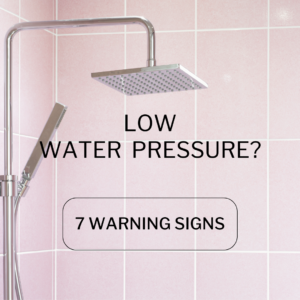
Trickling Faucets
One of the first and most obvious signs of low water pressure is trickling faucets. You turn on the tap expecting a strong, steady stream of water, but all you get is a weak dribble. This can be particularly frustrating when you’re trying to fill up a pot of water to cook dinner or wash your hands quickly.
Customer Story: One of our customers, Sabrina from Sapulpa, called us when she noticed her kitchen faucet was barely dribbling water. She initially thought it was mineral build up in her faucet, but after we inspected her home, we discovered the pressure regulator valve had malfunctioned. A quick replacement got her water pressure back to normal, and Sabrina was able to cook her famous pasta without any delays.
Poor Performance in Showers
Another telltale sign is weak showers. If your morning shower feels more like a gentle sprinkle than a refreshing blast, you likely have a water pressure issue.
Quick Tip: Try cleaning the showerhead first, as mineral deposits can sometimes clog the nozzles and reduce pressure. If that doesn’t work, the problem is likely deeper in your plumbing system.
Inconsistent Water Flows
Do you notice your water pressure fluctuates? One minute you have a decent stream, and the next it’s barely a trickle. This inconsistency can be a sign of issues with your main water line or an aging plumbing system. It could also indicate a blockage or leak somewhere in your pipes.
Extended Fill Time for Appliances
If your dishwasher or washing machine is taking longer than usual to fill up, low water pressure could be the culprit. These appliances require a certain amount of pressure to operate efficiently, and when the pressure is too low, they can’t perform at their best.
Reduced Pressure in Multiple Fixtures
When more than one fixture is experiencing low pressure simultaneously, it’s a strong indicator of a broader problem. This could be a sign of a significant issue with your main water supply line or a serious leak within your system.
Whistling or Banging Pipes
Low water pressure doesn’t always manifest as a slow trickle. Sometimes, it’s accompanied by strange noises like whistling or banging. These sounds often indicate that air is trapped in your pipes due to a leak or that the water flow is being obstructed, causing pressure changes that lead to noise.
Spiking Utility Bills
Lastly, if you notice your water bills have spiked without a corresponding increase in water usage, it could mean you have a leak somewhere in your plumbing. Leaks often cause pressure drops, as water escapes from the system before it reaches your fixtures.
Real Customer Story: John’s Leaky Dilemma
One of our long-time customers, John, noticed his water bill had doubled over the past two months. He hadn’t changed his water usage habits, so he called us to check it out. Upon inspection, we found a small, yet steady leak in his underground water line. The leak was causing a drop in pressure throughout his home, and the escaping water was racking up his bill. After fixing the leak and restoring the pressure, John’s water bill returned to normal, and he avoided further unnecessary expenses.
Causes of Low Water Pressure
Understanding the causes of low water pressure can help you prevent and address these issues more effectively. Some common causes include:
- Clogged Pipes: Over time, mineral deposits and debris can accumulate in your pipes, restricting water flow and reducing pressure.
- Leaks: Even a small leak can cause a significant drop in water pressure as water escapes the system.
- Pressure Regulator Issues: If your pressure regulator malfunctions, it can cause your water pressure to drop or fluctuate.
- Corroded Plumbing: Older plumbing systems, particularly those made from galvanized steel, can corrode and restrict water flow, leading to low pressure.
- Municipal Supply Problems: Sometimes, the issue isn’t within your home but with the municipal water supply. Maintenance work or problems at the local water plant can temporarily reduce water pressure.
What Do You Do About Low Water Pressure
If you’re experiencing any of these warning signs, it’s essential to address the issue promptly to prevent further damage and inconvenience. Here are a few steps you can take:
- Check for Clogs: Clean out any aerators or showerheads to remove mineral buildup that might be causing the problem.
- Inspect for Leaks: Look for visible signs of leaks around your home. If you find any, call a professional plumber immediately.
- Test the Pressure Regulator: If you have a pressure regulator, consider having it tested or replaced if you suspect it’s malfunctioning.
- Consult a Professional: For more complex issues, such as pipe corrosion or problems with your main water line, it’s best to call in the experts. At Green Country Plumbing, we have the tools and expertise to diagnose and fix low water pressure issues efficiently.
Conclusion
Low water pressure can be more than just an annoyance; it can signal serious issues within your plumbing system. By keeping an eye out for these warning signs, you can address problems early and avoid more significant damage down the road.
For more information on dealing with low water pressure, check out this helpful resource.
Remember, if you’re ever in doubt or need professional assistance, give us a call at Green Country Plumbing. We’re here to help keep your water flowing smoothly.
Happy Plumbing!

